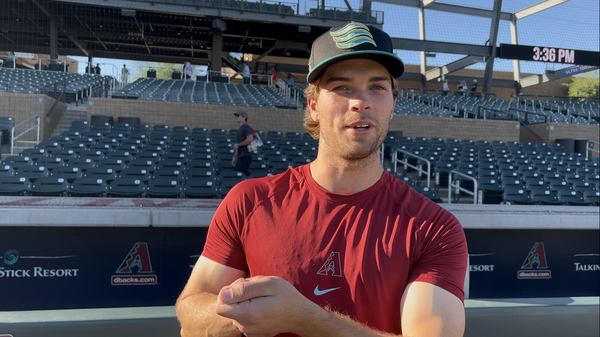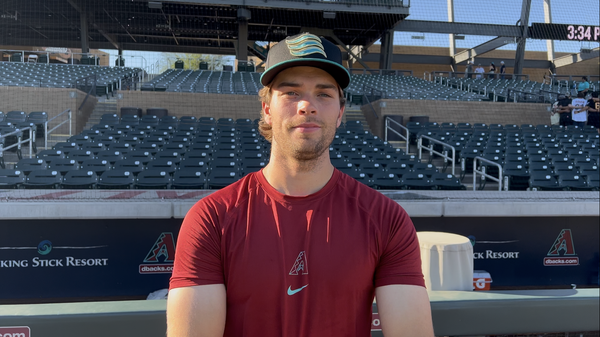Tristin English Scouting Report: Power Potential, Platoon Upside, and a Path to the Majors
The former 2019 draft pick has put together a solid season with Triple-A Reno and could be in position for an opportunity if the D-backs sell at the deadline.
One prospect who has flown under the radar this year has been Tristin English. While he’s nowhere near any prospect list concerning the Arizona Diamondbacks, the 28-year-old has made a push for a major league opportunity.
English was drafted in the 3rd round of the 2019 MLB Draft out of Georgia Tech. A former two-way player in college, he focused strictly on hitting since signing.
Thanks for reading Mike's D-backs Report! Subscribe for free to receive new posts and support my work.
In 53 games with Triple-A Reno, he’s batting .336 with seven home runs and a .920 OPS. Adjusting his offensive production for the offense-friendly Pacific Coast League and the high elevation park in Reno, FanGraphs estimates him to be 20% better than the average hitter with a 120 wRC+.
While it’s not necessarily outstanding production for a player that’s old for the level, it is English’s best mark in three seasons in Triple-A. In the last two seasons, his wRC+ with Reno was 106 and 78. With openings coming up at both first base and possibly DH as well, English is in the right spot to get a chance if the Diamondbacks sell at the deadline.
Plate Discipline and Swing Data
English has the typical profile of a right-handed hitting power bat. There aren’t a lot of walks in his profile, coming at a 7.6% rate, but not a lot of strikeouts either at 13.7%. His strikeout rate has consistently come down in Reno with each year.
While he tends to chase out of the zone, with a 35.5% chase rate, it doesn’t come with a lot of swing-and-miss. It results in weak contact, with an average exit velocity of 80.5 MPH on batted balls.
That’s an area he’ll need to improve, as the last area of development will be to identify pitches he can lift and drive. He’ll need to zone in more, especially when ahead in the count, and wait for that pitch. Otherwise, pitchers will exploit his chase tendency for easy outs.
When he swings at strikes, he is pretty solid at putting the bat on the ball. His overall zone whiff rate is 16.0%, just a percentage point below the MLB average of 17.0%. As a power bat, he makes a healthy amount of contact.
Batted Ball Profile
While power is his carrying tool, his batted ball profile doesn’t quite maximize that one tool. He yields a ground ball rate of 45.3%, which is close to the MLB average but is also too high for his skill set. He has a habit of getting on top of too many pitches, with 61 of his 181 batted balls recording a launch angle of 0° or less.
The ground ball tendency is a key issue as to why English hasn’t gotten a call-up already. It limits his ability to do damage, even if he hits it hard. His barrel rate is only 8.8%, which is a solid number but certainly could be higher with his exit velocity profile. His hard-hit (exit velocities of 95.0 MPH or greater) rate is 42.0%. So it’s a matter of optimizing launch angles to make him a more reliable power bat.
When he does get the ball in the air, he does damage. His average exit velocity on line drive and fly ball contact is 93.7 MPH, which is above the MLB average of 93.4. When he hits the ball in the launch angle sweet spot range of 8-32°, his average exit velocity is 94.7 MPH.
Another carrying metric for projecting power is a player’s 90th-percentile exit velocity. For English, he clocks in at 104.2 MPH, slightly above the MLB average of 103.8.
Pitch Data
One area that often goes under the radar when doing a prospect analysis is how they handle specific pitches. In English’s case, he handles all three specific pitch types fairly well. One thing to note is the quality of secondary stuff and velocity is higher at the major league level.
Against fastballs that are 95.0 MPH or greater, English is hitting .387 with a .581 slugging percentage. However, the production begins to drop at 97 MPH or greater (.286 BA, .286 SLG). That’s not a weakness unique to English, as most major league hitters struggle against that velocity, so it’s not a disqualifier.
His ability to hit secondary pitches separates him from Trey Mancini, a fastball killer. He’s hitting .377 with a .623 slug against breaking pitches. He handles right-on-right spin fairly well, as the numbers improve to a .393 average and a .643 slug this season.
Against offspeed pitches, he’s hitting .381 with a .524 slug. When facing lefties, who are more likely to turn to those pitches against him, English is hitting .364 and slugging .545.
With the pitch data, and his ability to handle different pitch types in Triple-A, he has earned a call-up to the major leagues.
Projected Future Role with the Diamondbacks
English probably isn’t an everyday regular due to his defensive limitations and chase profile, but could fill the right-handed portion of the DH platoon with Pavin Smith. Against lefties, he’s slashing .364/.404/.682 in the minor leagues this season.
Randal Grichuk is a candidate to be moved at the deadline for a team looking for a fourth outfielder and occasional DH. Should he be moved, that opens up a potential role for English. Since he’s on the short side of the platoon, and limited to first base defensively, there isn’t much roster flexibility the team could have as opposed to having an outfielder fill that role. That shouldn’t be a concern, as the final two months should be an evaluation period for 2026.
Should English look solid in his first MLB stint, the team can save money on their DH platoon and focus on building their decimated pitching staff. If not, he’s got three options and serves as depth at both first base and DH.
As a former two-way player, English can also serve as emergency pitching depth should the Diamondbacks’ bullpen have a very rough night or the team runs out of pitchers.
Thanks for reading Mike's D-backs Report! Subscribe for free to receive new posts and support my work.
Mike’s D-backs Report is a Substack-based publication created by Michael McDermott, who has covered the Arizona Diamondbacks and their farm system for over 10 years. Since this takes time and effort to produce, and paid subscriptions are currently turned off, I’m asking for your support to help keep this page going. If you’re able to leave a small tip, I’d truly appreciate it.



